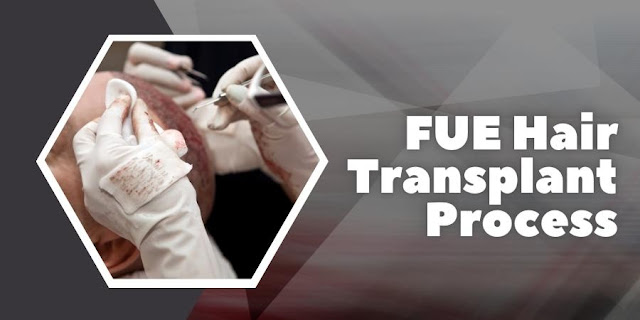Follicular Unit Extraction (FUE) is a popular and advanced surgical technique for hair transplantation. It involves the extraction of individual hair follicles from a donor area and their transplantation to the recipient area, typically where hair loss or thinning has occurred. Here's an overview of the FUE hair transplant process:
Consultation:
 |
| FUE Hair Transplant Process |
The first step is to schedule a consultation with a qualified and experienced hair transplant surgeon. During this consultation, you will discuss your goals, expectations, and assess your suitability for the procedure. The surgeon will also examine your donor and recipient areas to determine the feasibility of the transplant.
Preoperative Preparations:
Before the surgery, your surgeon will provide you with instructions on how to prepare for the procedure. This may include avoiding certain medications, alcohol, or smoking for a period before the surgery.
Anesthesia:
On the day of the procedure, you will be given local anesthesia to numb both the donor and recipient areas. This ensures that you don't feel any pain during the surgery.
Donor Area Extraction:
In the FUE technique, the surgeon uses a specialized micro-punch instrument to extract individual hair follicles from the donor area, which is usually the back or sides of the scalp. The punches are typically very small (around 0.8 to 1.0 mm in diameter) to minimize scarring and damage to surrounding tissue.
Follicle Collection:
The extracted hair follicles are carefully collected and stored in a special solution to keep them viable until they are transplanted.
Recipient Area Preparation:
Once the donor follicles are collected, tiny incisions or slits are made in the recipient area in the pattern and angle that mimics natural hair growth.
Graft Implantation:
Individual hair follicles are then meticulously implanted into the recipient area using fine needles or micro-blades. The surgeon takes care to ensure the proper angle, density, and distribution for a natural appearance.
Postoperative Care:
After the procedure, the surgeon will provide you with postoperative care instructions. You may be prescribed antibiotics and pain medication to prevent infection and manage discomfort. You'll also be given guidance on how to care for your newly transplanted hair.
Recovery:
FUE is a minimally invasive procedure, and most patients can return to their regular activities within a few days. However, you should avoid strenuous activities for a couple of weeks to allow the transplanted follicles to heal and take hold.
Hair Growth:
It's important to note that the transplanted hair will shed in the weeks following the procedure. This is normal, and new hair growth typically begins after a few months. The final results can take up to a year to become fully visible.
FUE hair transplantation is known for its minimal scarring and natural-looking results, making it a preferred choice for many individuals seeking to restore their hair. It's essential to choose a skilled and experienced surgeon to ensure a successful outcome.

FUE hair transplantation is known for its minimal scarring and natural-looking results, making it a preferred choice for many individuals seeking to restore their hair. It's essential to choose a skilled and experienced surgeon to ensure a successful outcome.
ReplyDelete